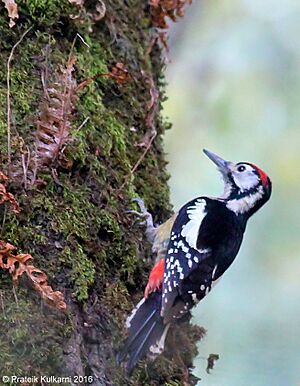Himalayan woodpecker facts for kids
Quick facts for kids Himalayan woodpecker |
|
|---|---|
 |
|
| Male at Pangot in Nainital district of Uttarakhand, India | |
| Conservation status | |
| Scientific classification | |
| Genus: |
Dendrocopos
|
| Species: |
himalayensis
|
The Himalayan woodpecker (Dendrocopos himalayensis) is a type of bird. It belongs to the Picidae family, which includes all woodpeckers.
You can find this bird in the northern parts of the Indian subcontinent. It mainly lives in the Himalayas mountains and nearby areas. Its home countries include Afghanistan, India, Nepal, Bhutan, and Pakistan.
This woodpecker prefers to live in cool, northern forests. It also lives in milder, temperate forests. Experts say it's a "least concern" animal. This means it's not currently in danger of disappearing.
Contents
What Does It Look Like?
The Himalayan woodpecker is a medium-sized bird. It grows to be about 24 cm (9 in) long. It has a mix of black and white colors.
Its back is shiny black. It has wide white patches from its shoulders down to its lower back. Its flight feathers have some white stripes. The edges of its tail are also clean white.
The bird's belly and head are white or a light, creamy color. It has a black Y-shaped mark on its neck and cheeks. Males have a red top of the head (crown). Females have a black crown.
Look for unique black marks under its eyes. These marks help tell it apart from other woodpeckers. The area under its tail is red or pink. Its eyes are chestnut brown, its beak is blackish, and its legs are grey.
Young woodpeckers look a bit different. They are duller, with a greyish-black back. Their under-tail areas are less bright. Their crown is greyish, but it might have some red color in both young males and females.
Where Does It Live and What Does It Eat?
The Himalayan woodpecker lives in high places. You can find it at heights between 1,500 and 3,200 m (4,900 and 10,500 ft). Its home is usually in wet or dry mountain forests. These forests can have deciduous trees (which lose their leaves) or coniferous trees (like pine trees). Often, there are also rhododendron plants.
This woodpecker usually looks for food by itself. It mostly searches on tree trunks and large branches. Sometimes, it will even look for food on the ground.
It eats many different things. Its diet includes insects, fruits, and seeds. It also drinks tree sap. Sometimes, it uses stones to crack open fir cones. This helps it get to the tasty seeds inside.
Is It Safe?
The Himalayan woodpecker lives in a very large area. It is generally a common bird, or at least fairly common. Experts have not found any special threats to this bird. Its population seems to be staying steady.
Because of this, the International Union for Conservation of Nature says it is a "least concern" species. This means it is not in danger of becoming extinct right now.
Images for kids






